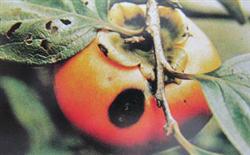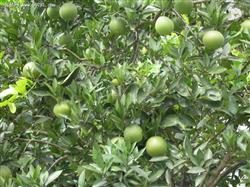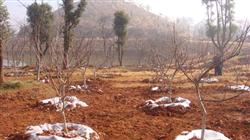How to prevent and cure anthracnose of persimmon?

How to control persimmon anthracnose? Colletotrichum gloeosporioides is one of the main diseases of persimmon trees. It is necessary to scientifically distinguish the symptoms and characteristics of the disease, understand the incidence rules, and take comprehensive measures to control it in time. 1. Symptom characteristics: This disease mainly damages fruits and new shoots, and leaves rarely occur. At the early stage of fruit disease, large dark brown spots appeared on the needle, and then the disease spots expanded to be nearly round, concave, and the diameter of the disease spots was 5~10 mm. The middle of the disease spots was densely covered with gray to black small spots (conidia). When the air is humid, pink sticky matter (conidia) emerges from the diseased part; there are usually one or more diseased spots on a diseased fruit, and the affected fruit is easy to soften and fall off. At the initial stage of the disease, small black spots appeared, then expanded into oval and brown, the middle part of the disease was depressed and split, and small black spots appeared. The disease spots were 10~20 mm long and 7~12 mm wide. The new shoots were easy to break off from the diseased parts. In severe cases, the parts above the disease spots died. Persimmons leaf disease, first from veins, petioles turn yellow, then black, leaf spots were irregular shape. 2. Pathogenesis rule: The pathogen mainly overwinters in the diseased spots of branch tips by mycelium, and can also overwinter conidia in the diseased dry fruits, leaf scars and winter buds; the conidia are produced in early summer of the second year for primary infection, and the conidia are transmitted by wind and rain to invade the new shoots and young fruits; the conidia can be infected many times during the growth period, and the pathogen can enter directly from the wound or epidermis. When there is a wound, it is easier to invade and harm. The incubation period is 3~10 days. In the northern fruit area, in general years, the disease begins in early June, the rainy season is the peak period of disease, and the autumn shoots can continue to suffer; the disease period of fruits generally begins in late June and early July until the harvest period, and the fruits begin to fall off in late July when the disease is serious. Colletotrichum gloeosporioides likes high temperature and high humidity, and the temperature rises after rain, so it is easy to appear the peak period of incidence; the incidence is heavy in rainy years in summer and light in dry and early years; the optimum temperature for pathogen development is about 25℃, lower than 9℃ or higher than 35℃, which is not conducive to the occurrence and spread of the disease; extensive management and weak tree vigor are easy to occur. 3. Control measures: (1) Clean the orchard and thoroughly remove the bacteria source. In winter, combine pruning, thoroughly clean the garden, cut off the diseased branches and remove the diseased fruits; cut off the diseased branches and remove the diseased fruits in time in the growing season, burn or bury the removed diseased branches, fruits and leaves in a centralized manner, so as to reduce the re-infection bacteria source. Before sprouting, spray Baume 5 degree sulfur mixture. (2)Improve water conservancy construction to ensure smooth drainage and irrigation. Too much rain, poor drainage, aggravated disease occurrence, therefore, before the arrival of rainy season, water conservancy facilities should be improved to ensure that rain stops the field dry, timely moisture reduction. (3)Improve permeability and prevent stagnation in the garden. Through summer pruning, dense crowded branches, thin branches and diseased branches were cut off, ventilation and light transmission conditions in the garden were improved, and field humidity was reduced. (4)Balanced fertilization promotes tree health. Apply more organic fertilizer, phosphorus and potassium fertilizer, and less nitrogen fertilizer to avoid excessive growth of branches and reduce disease resistance. (5)6 From the middle of July to the middle of July, Bordeaux mixture of 1:5:400~500 times was sprayed twice. In order to avoid affecting the appearance luster of fruits in late July, 70% thiophanate-methyl 800~1000 times was used to control (mixed with 0.2%~0.5% urea to avoid phytotoxicity). Click for more persimmon tree planting technology Click for more fruit planting technology
- Prev

How to manage navel orange in June
How to manage navel orange in June? Please give a detailed introduction to the management methods in June navel orange management mainly have the following points: 1, adult tree management 1. Continue to erase summer shoots to protect fruit. 2. Weeding and loosening, covering the adult trees with small crown and unsealed rows with tree trays. 3. Continue to prevent umbilical yellow fruit,...
- Next

How to plant sweet persimmons?
How to plant sweet persimmons? Sweet persimmon is one of the most treasured persimmons imported from Japan in China. There are more than ten varieties, such as Shinjiro, Fu, Izu, Nishimura and so on. It has high value of nutrition and health care, resistance to storage and transportation, good commerciality, and has excellent development prospects. Now introduce its high-quality and high-yield cultivation techniques as follows:.
Related
- Moge, come on! The staff of the peasant association in the producing area of cantaloupe were frightened when the crowd gathered.
- Causes and Solutions of low Fruit setting rate of Apple
- Symptoms and control measures of passion fruit virus disease
- Fruit growing lesson: how do apple orchards keep high yields?
- Can you build orchards in the mountains? What are the pros and cons?
- How to manage the coloring period of Crisson grape?
- This paper introduces the processing technology of two kinds of fig products.
- How much is a month for retired teachers in rural areas by 2020?
- How can strawberry planting increase sugar content? We should pay attention to management in many aspects.
- What are the cultivation techniques on how to improve the yield of golden fruit?

